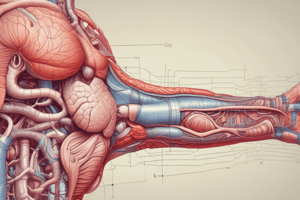Podcast
Questions and Answers
Which type of epithelium lines the oral cavity?
Which type of epithelium lines the oral cavity?
Stratified Squamous
Where in the human body would you find the fauces?
Where in the human body would you find the fauces?
The fauces is the opening between the oral cavity and the pharynx.
What is the difference between the enterogastric reflex and the gastroenteric reflex?
What is the difference between the enterogastric reflex and the gastroenteric reflex?
Enterogastric reflex inhibits gastric functions, while gastroenteric reflex increases motility.
How does enterokinase/enteropeptidase 'kick start' protein digestion in the duodenum?
How does enterokinase/enteropeptidase 'kick start' protein digestion in the duodenum?
How does bile aid in lipid catabolism?
How does bile aid in lipid catabolism?
____ is the bony substance that covers the ___ in the root region and anchors the tooth to the periodontal ligament.
____ is the bony substance that covers the ___ in the root region and anchors the tooth to the periodontal ligament.
Seventy percent of the pancreatic enzymes are
Seventy percent of the pancreatic enzymes are
____ reflex is stimulated by the arrival of food in the stomach.
____ reflex is stimulated by the arrival of food in the stomach.
___ cells of the gastric glands secrete H+, Cl-, and intrinsic factor.
___ cells of the gastric glands secrete H+, Cl-, and intrinsic factor.
During __ phase of gastric secretion, gastric acid and pepsinogen production are inhibited.
During __ phase of gastric secretion, gastric acid and pepsinogen production are inhibited.
There are about 800 permanent transverse folds in the small intestine called
There are about 800 permanent transverse folds in the small intestine called
___ is produced from the ___ so that lipids are ___.
___ is produced from the ___ so that lipids are ___.
___ is the condition of having gallstones.
___ is the condition of having gallstones.
This 10 inch to 1 foot muscular tube transports bolus.
This 10 inch to 1 foot muscular tube transports bolus.
The stomach is mostly on what side of the body?
The stomach is mostly on what side of the body?
Flashcards are hidden until you start studying
Study Notes
Key Structures and Functions
- The oral cavity is lined with stratified squamous epithelium for protection against abrasion.
- Fauces is the anatomical opening connecting the oral cavity to the pharynx, facilitating the passage of food.
Reflex Mechanisms
- Enterogastric Reflex: Triggered by the arrival of chyme in the duodenum; consists of baroreceptors and chemoreceptors that inhibit gastrin production, reduce stomach contractions, and tighten the pyloric sphincter, allowing the duodenum to process acidic chyme.
- Gastroenteric Reflex: Initiated by stomach stretching when filled with bolus; it enhances motility and secretion in the small intestine.
Protein Digestion
- Enterokinase (enteropeptidase): An enzyme found in the brush border of the small intestine that converts trypsinogen to trypsin, subsequently activating other pancreatic proenzymes to facilitate protein digestion.
Lipid Digestion
- Bile: Composed mainly of water, bile salts, ions, bilirubin, and cholesterol. It emulsifies lipids, increasing their surface area for digestion by lipases and aids in lipid absorption by the intestinal epithelium.
Dental Anatomy
- The cementum is the bony substance covering the root region of the tooth, anchoring it to the periodontal ligament, protecting the underlying dentin.
Pancreatic Enzyme Composition
- Seventy percent of pancreatic enzymes are proteolytic enzymes, which digest proteins.
Gastrointestinal Reflexes
- Gastroenteric Reflex: Activated by food arrival in the stomach, it increases peristalsis along the small intestine to facilitate digestion.
- Enterogastric Reflex: Functions as a feedback mechanism to regulate gastric activity in response to intestinal needs.
Secretion in Gastric Glands
- Parietal cells in gastric glands secrete hydrogen ions (H+), chloride ions (Cl-), and intrinsic factor, essential for vitamin B12 absorption.
Gastric Secretion Phases
- Intestinal phase: Gastric acid and pepsinogen production are inhibited during this stage to prevent excess acidity in the small intestine.
Structural Features of the Small Intestine
- The small intestine has approximately 800 permanent transverse folds known as plicae, which increase the surface area for nutrient absorption.
Lipid Preparation
- Bile, produced by the liver, emulsifies lipids, making them easier for digestion.
Gallstone Condition
- Cholelithiasis: The medical term for the condition of having gallstones.
Esophagus Characteristics
- The esophagus is a muscular tube, averaging 10 inches to 1 foot in length, responsible for transporting bolus from the pharynx to the stomach.
Stomach Orientation
- The stomach is primarily situated on the left side of the body, playing a significant role in digestion.
Studying That Suits You
Use AI to generate personalized quizzes and flashcards to suit your learning preferences.




